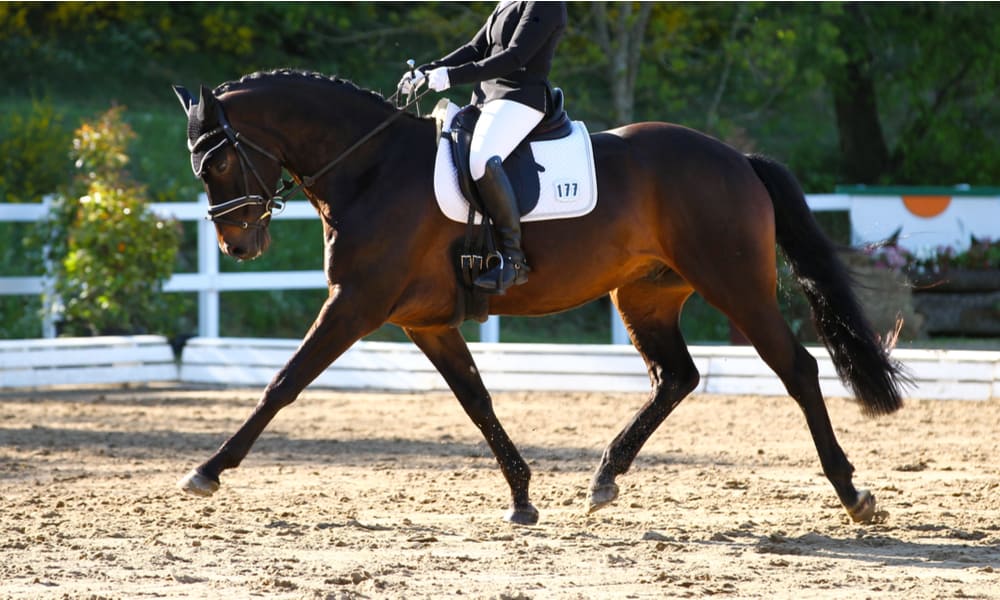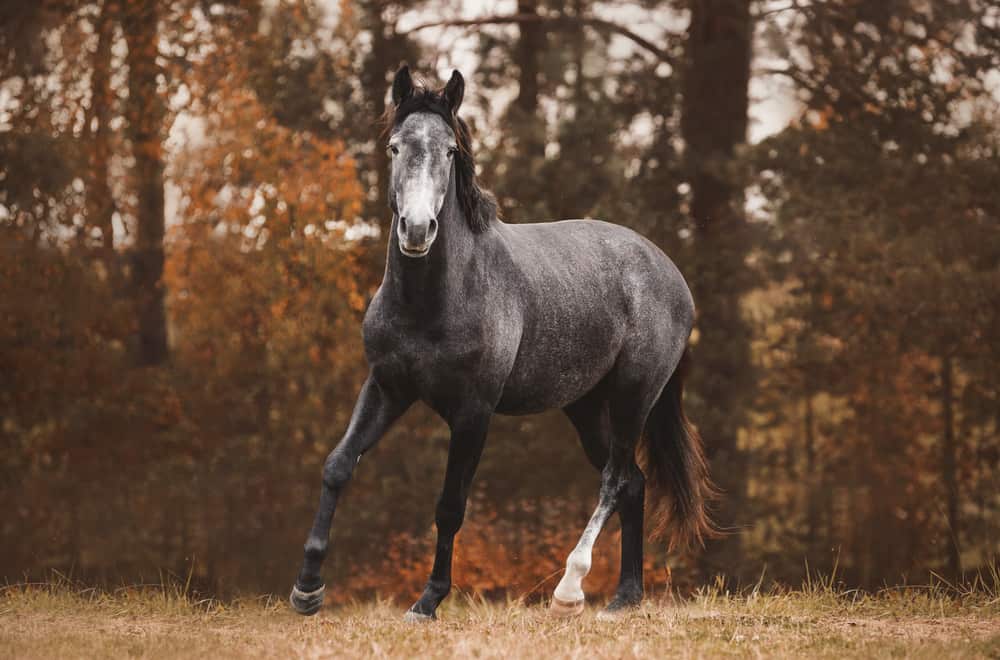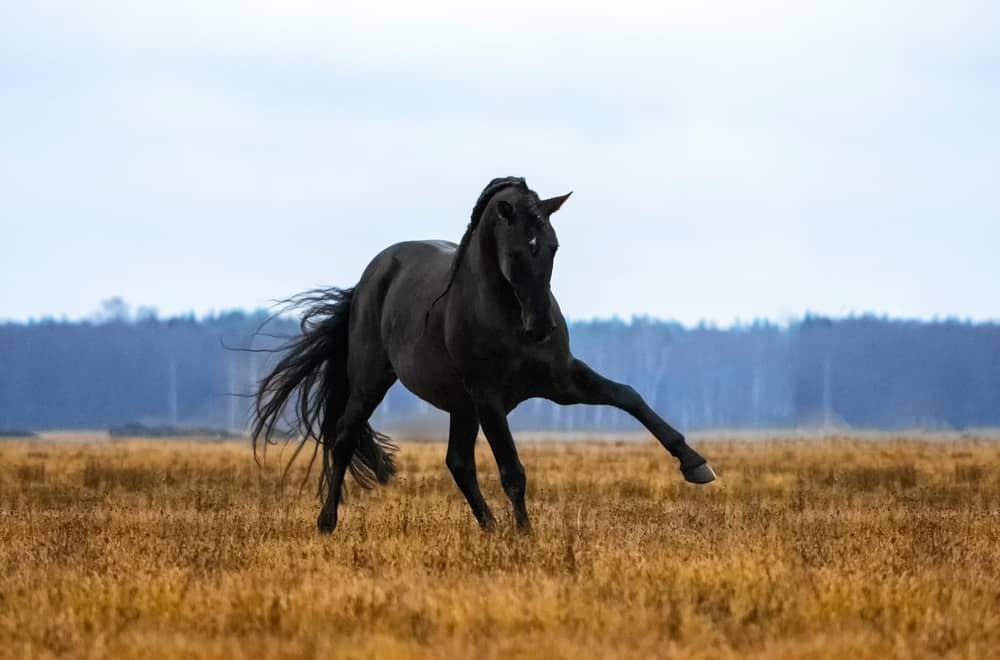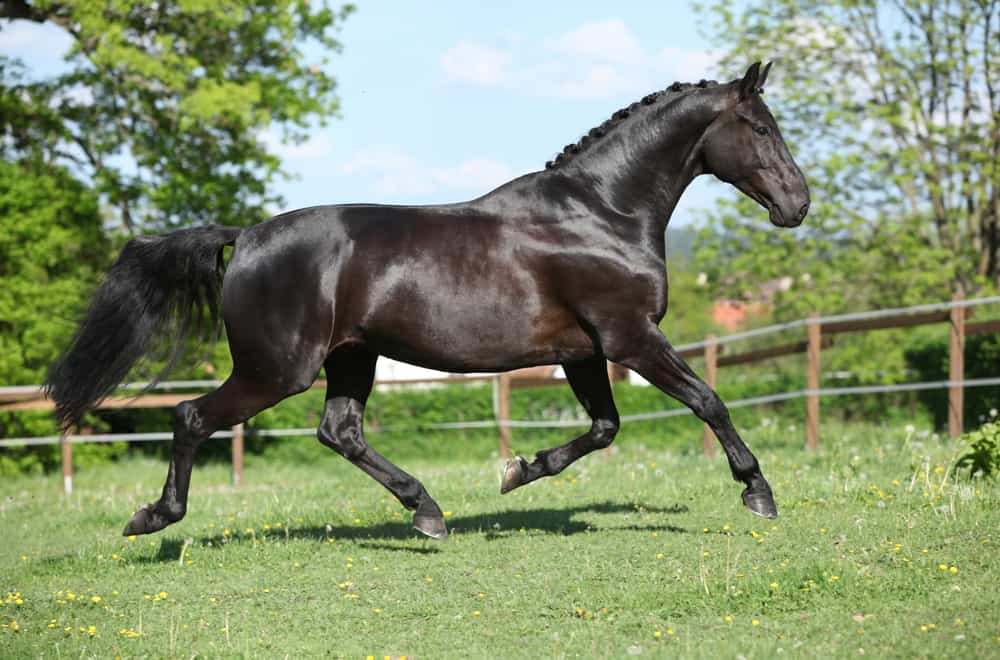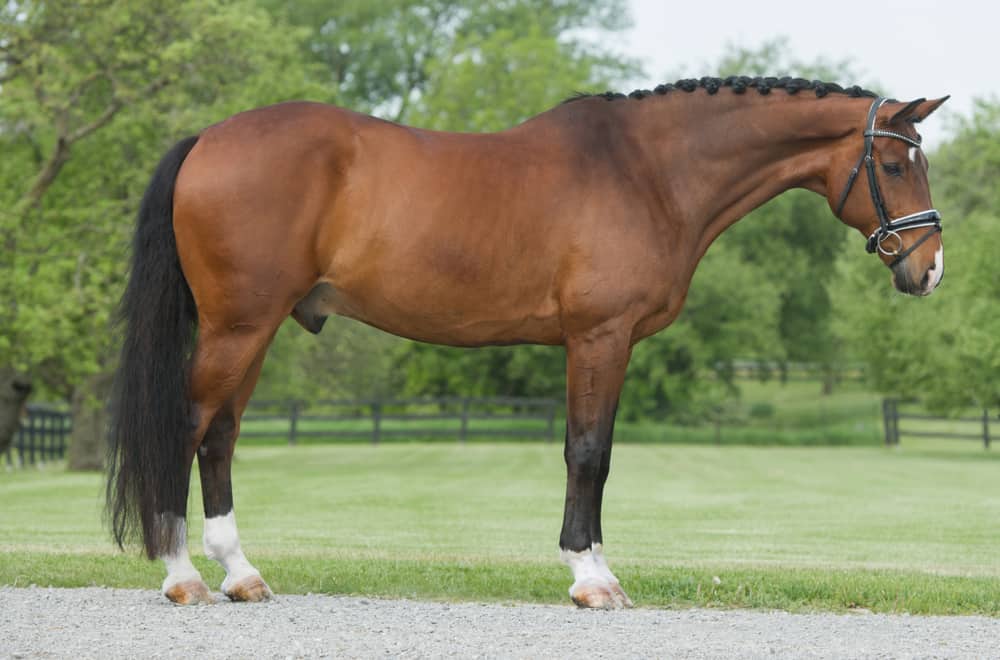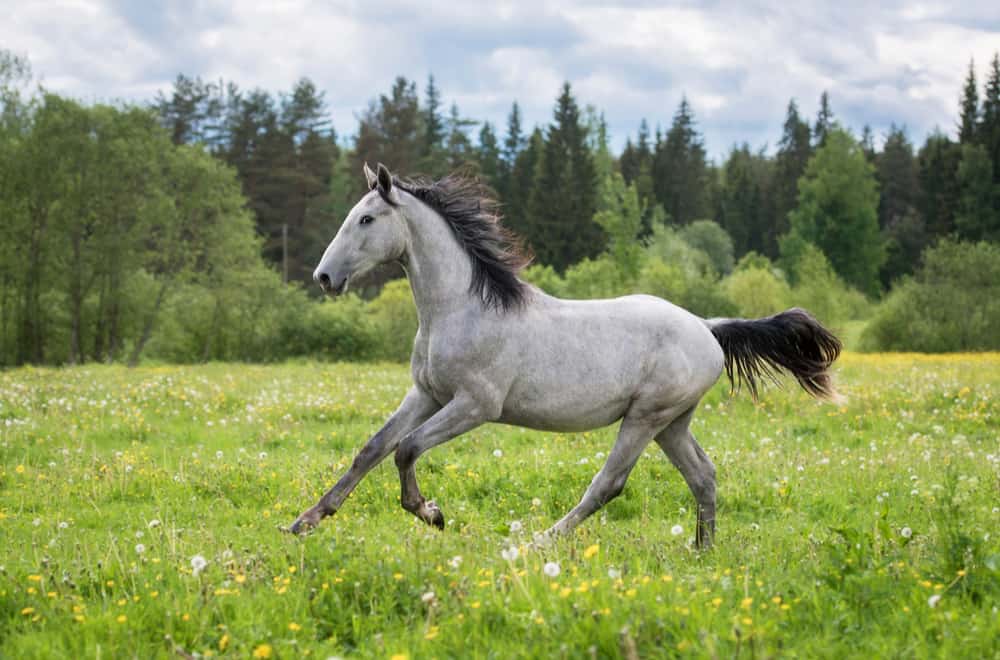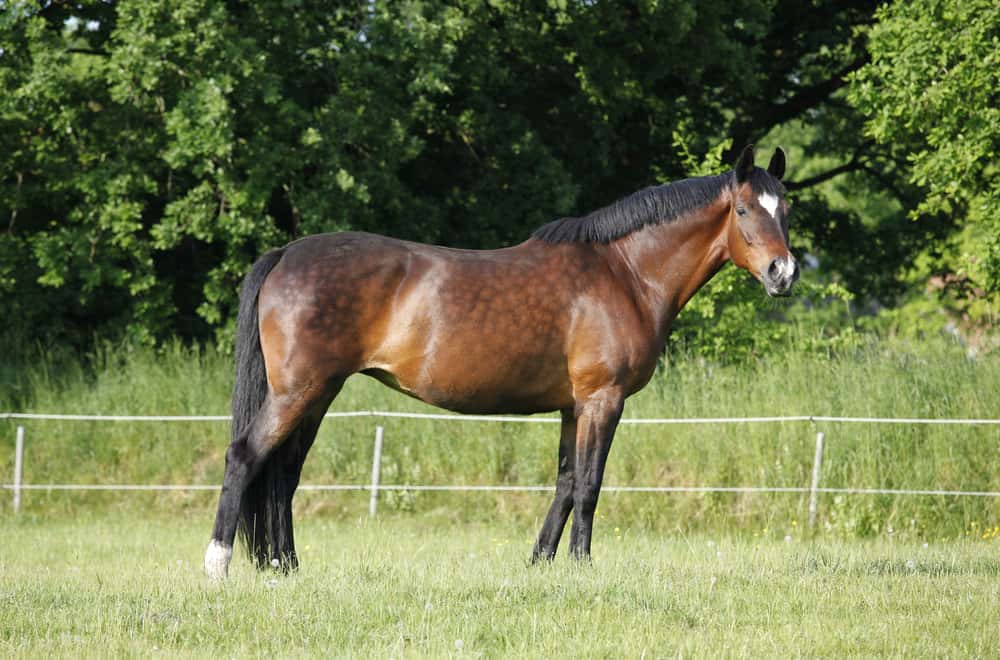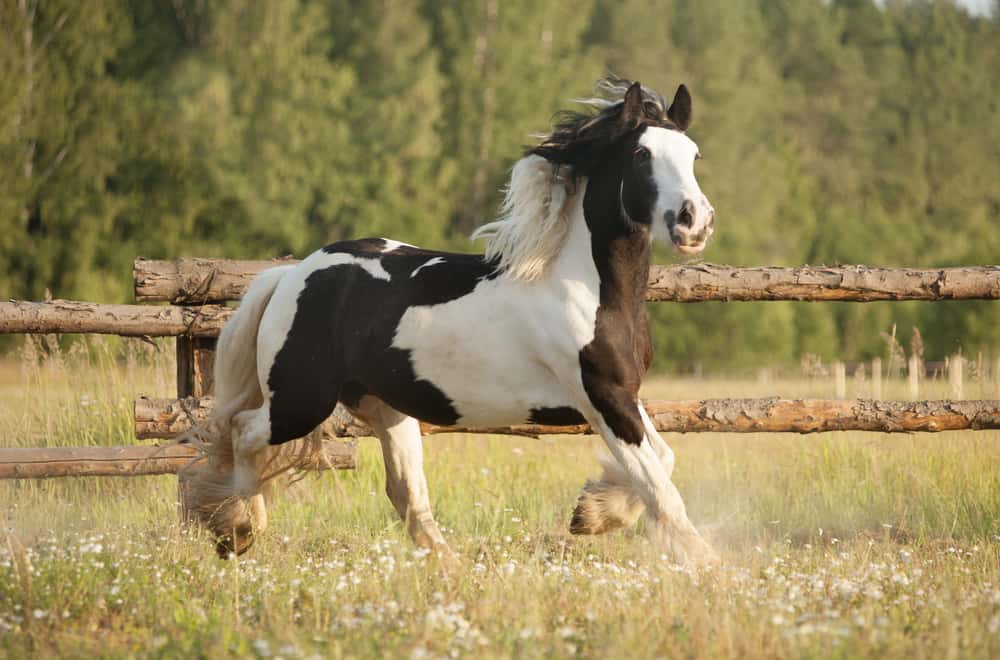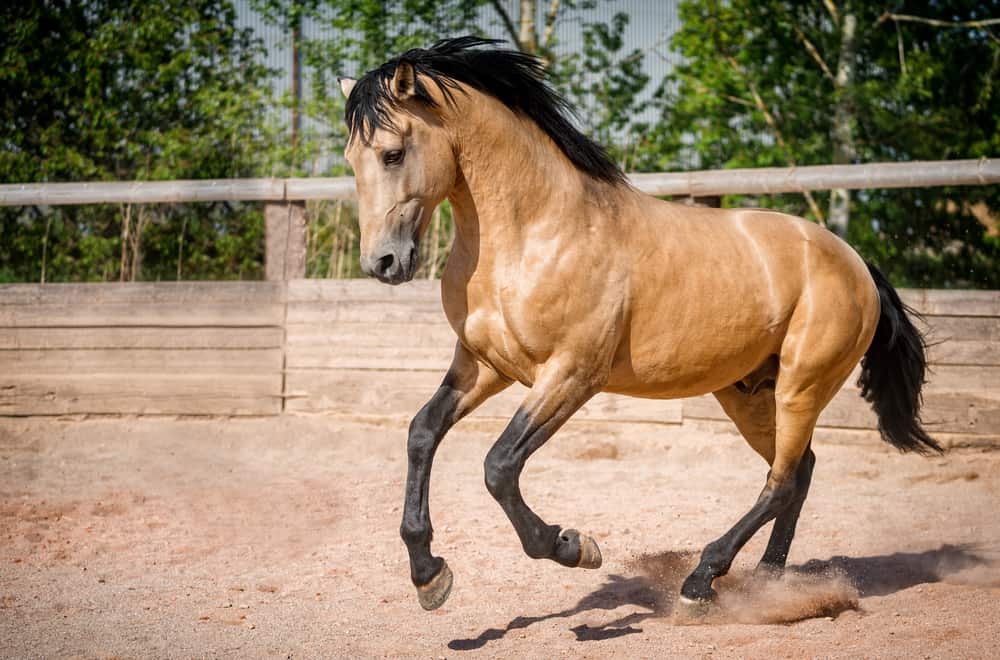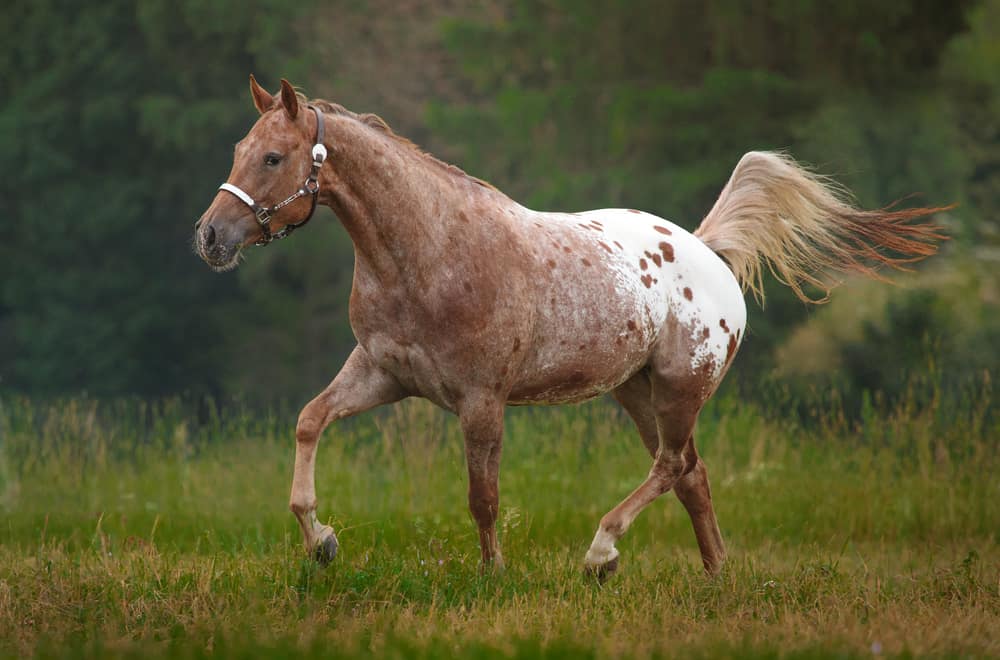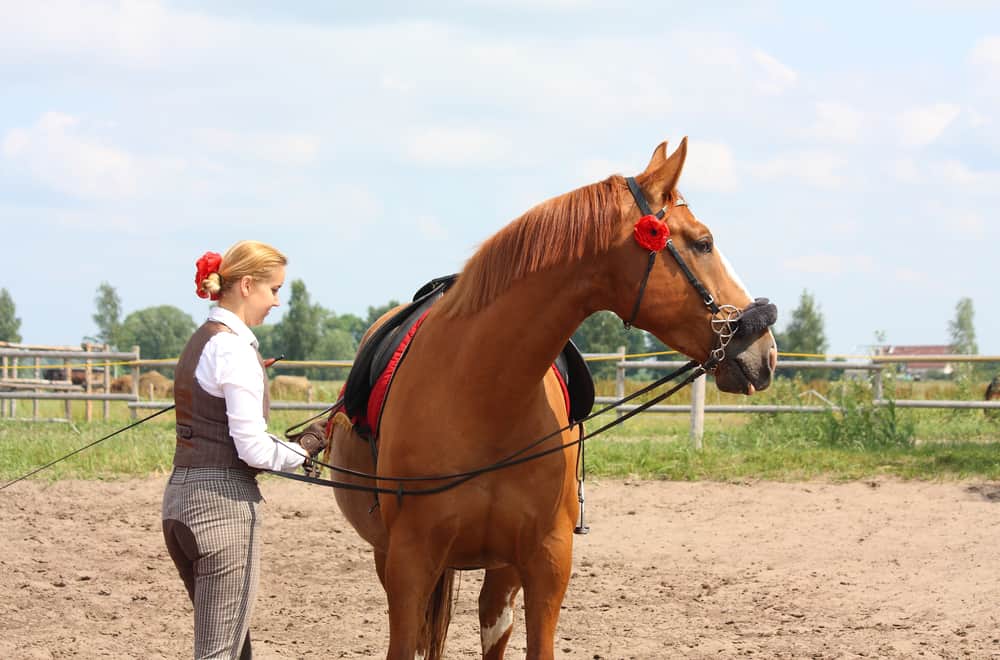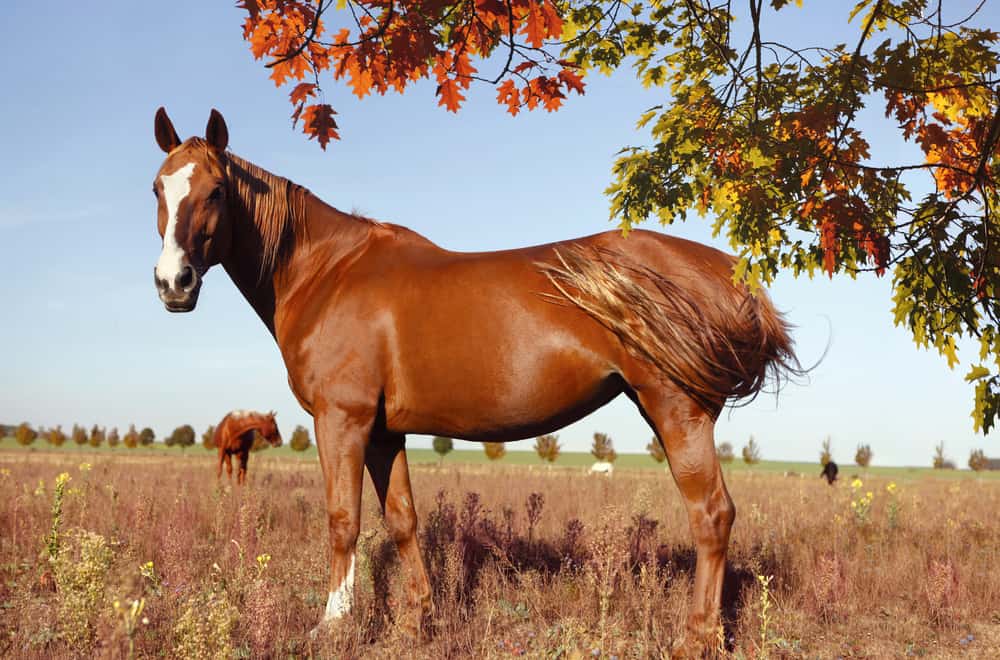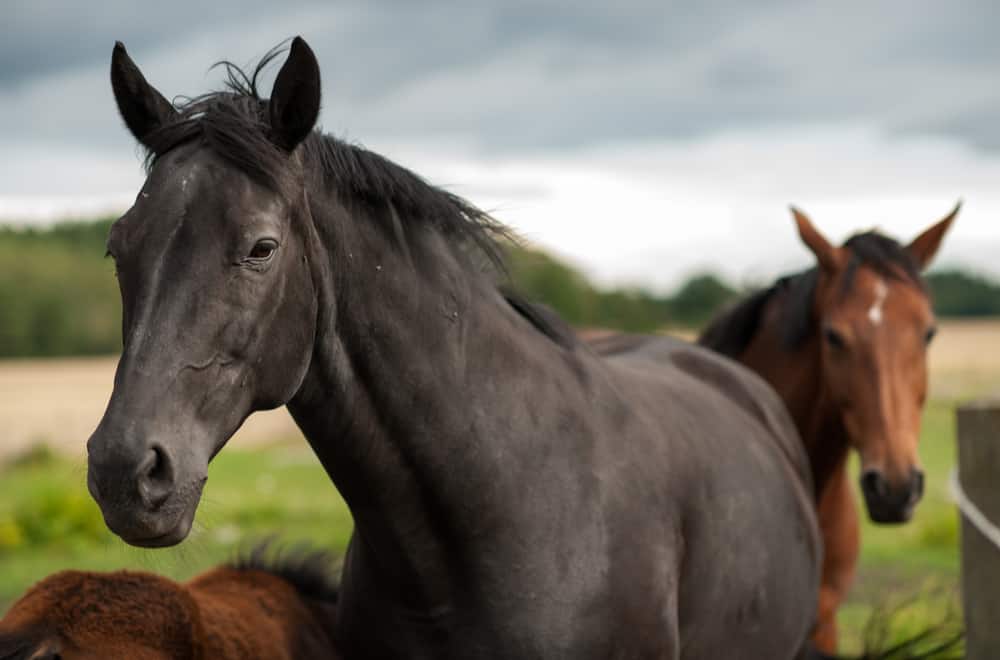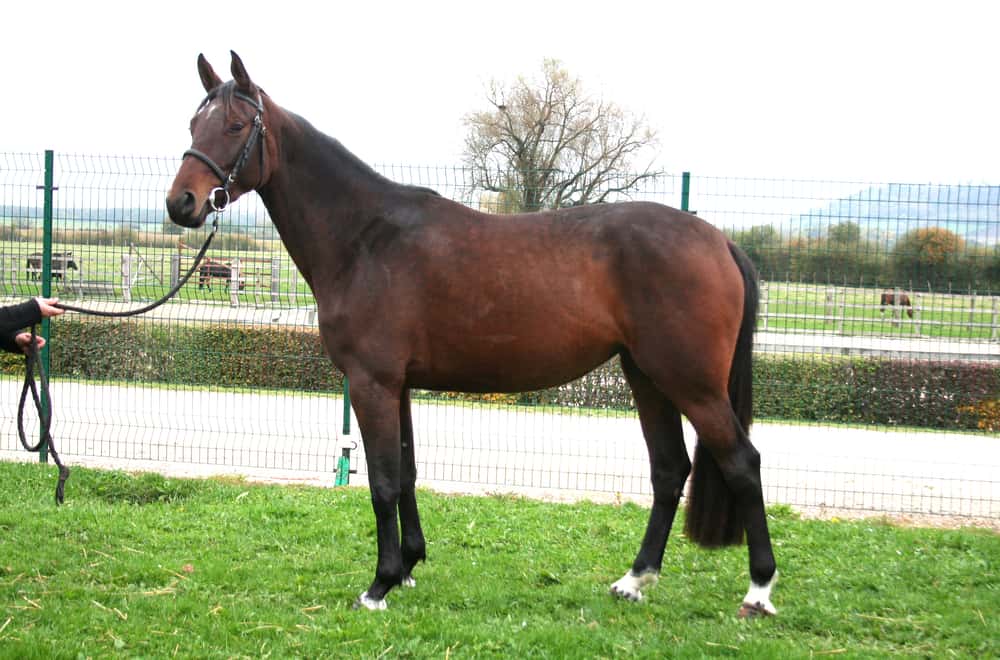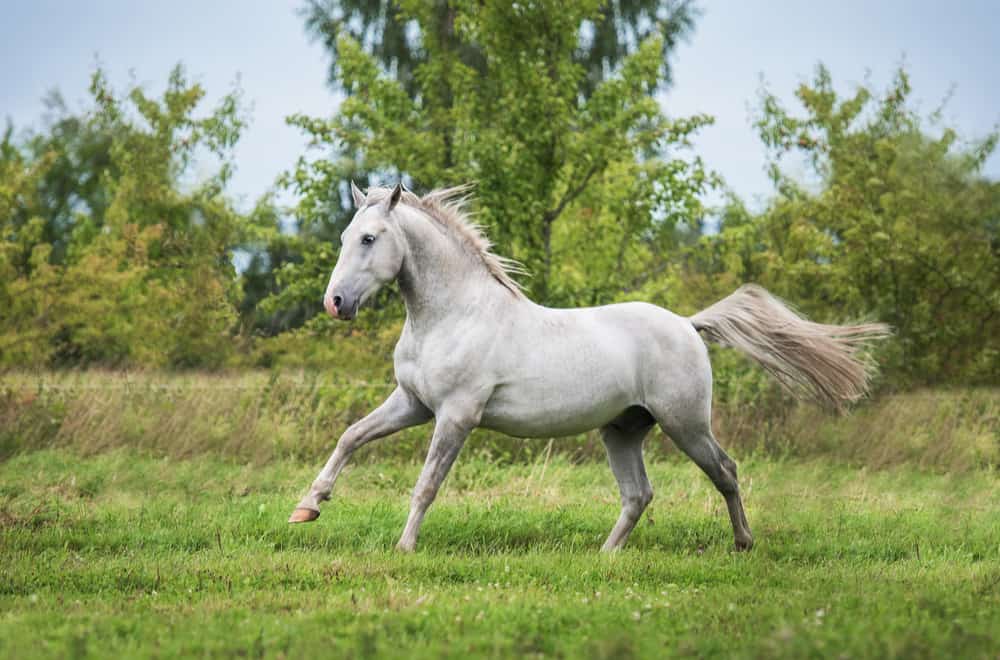The equestrian discipline of dressage calls for excellent communication between horse and rider. And the skill and agility required to execute moves from memory means it’s better suited to some breeds than others.
So what are the best dressage horse breeds?
That’s what we’re here to find out! We’re going to look at some of the horses best suited to this exacting discipline. And we’ll learn just what it is that makes them so good.
So trot this way to find out more!
1. Trakehner
The Trakehner is renowned as the lightest and most refined of the warmblood breeds. Its name comes from the town where it was first developed, Trakehnen in East Prussia.
These elegant horses usually stand between 15.2 and 17 hands. Their long shoulders, finely shaped heads and powerful hindquarters are evidence of their Thoroughbred ancestry. And they’re willing and athletic animals, with a sensitivity and intelligence that makes them highly prized in dressage.
It was a Trakehner named Peron that was the lynchpin in the USA dressage team that won Olympic bronze in 1996. And another famous Trakehner stallion, Beatos, not only competed in both show jumping and dressage, but became the famous mascot of Lloyds bank’s television commercials.
They’re also skilled at eventing. Their lighter build makes them more successful in this discipline than most of the other warmblood breeds.
2. Andalusian
The Andalusian is a native of the Iberian peninsula. You may also hear it referred to as the PRE, which stands for pura raza española, or Real Spanish Horse.
It was first recognised as a breed way back in the fifteenth century, and modern Andalusians look very similar to their ancestors. They have a compact, strong build, and long luxurious manes and tails.
From the earliest times, they were used for classical dressage, as well as driving and bullfighting. Today’s horses retain a temperament that makes them well suited to dressage. They’re quick studies and cooperative with their riders. And they take complicated movements in their stride.
Their success in the discipline is reflected in the selection for the 2021 World Championship for Young Dressage Riders. The entire Spanish team for the competition was composed of Andalusian horses.
3. Dutch Warmblood
Dutch Warmbloods are registered with the Royal Warmblood Stud Book of the Netherlands, the KWPN. They’re the results of a drive to breed successful competition horses, which began in the 1960s.
Today the KWPN has four categories of horse, amongst them riding horses bred for dressage and show jumping. The strict criteria for breeding is designed to ensure that all KWPN horses are capable of competing at the highest level.
As a result, Dutch warmbloods bred for dressage are cooperative, and easy to ride and handle. The World Breeding Federation for Sport Horses ranks the breed number 1 for both dressage and show jumping.
It’s perhaps not surprising, then, that there are many Dutch warmbloods amongst Olympic and world champions. Famous horses include Ferro and Udon. And the Dutch warmblood Moorlands Totilas holds the record for the highest ever score in Grand Prix Freestyle Dressage.
4. Hanoverian
The Hanoverian is another breed of warmblood, in this case originating from Germany. It was originally bred for military purposes, carrying soldiers into battle. Over the years, the breed was interbred with Thoroughbreds, producing a lighter and more agile horse.
The beautiful Hanoverian is known for its grace, good temper and athleticism. The horses usually stand between 15.3 and 17.1 hands. And their most common coat colors are black, chestnut, bay and gray.
The modern Hanoverian is well suited to competing. Representatives of the breed have won gold in all three equestrian Olympic events – dressage, show jumping and three-day eventing. Their medals haul for dressage includes three individual and four team golds.
The Hanoverian studbook is ranked the most successful in international dressage competitions. At the four-yearly World Equestrian Games, Hanoverians have won four individual and eight golds in the discipline.
5. Oldenburg
The Oldenburg, also known as the Oldenburger, is a warmblood breed that originates from Lower Saxony, now part of Germany.
Their history dates back centuries, but it wasn’t until the seventeenth century that they became highly desirable animals. Until then, their strength had made them useful in farming. But with selective breeding, they became an elegant, high-stepping horse, prized for pulling carriages.
It’s their gait for which they are particularly renowned. Even amongst warmbloods, they have a particularly elastic walk, with plenty of suspension.
All this means they’re an excellent horse for dressage, with Oldenburgs competing in the discipline at the Olympics.
The stallions Sandro Hit and Donnerhall have sired many champion Oldenburg horses. And the breed is third behind Dutch Warmbloods and Hanoverians in international rankings for the sport.
6. Holsteiner
Another warmblood from Germany, the Holsteiner is a relatively rare breed. Its origins date all the way back to the thirteenth century, a history longer than any other warmblood breed.
The average Holsteiner stands between 16 and 17 hands and has a medium build. Their heads are relatively small, and they have arched, high-set necks and muscular hindquarters. Their temperaments vary by individual horse, from cool and calm, to sensitive and spooky.
While its numbers are not large, the breed is highly successful in equestrian sports. Holsteiners do particularly well in dressage and show jumping, as well as in eventing, combined driving and show hunting.
In 2008, the Holsteiner studbook was ranked eighth in the world for international dressage. And the Holsteiner Montevideo was part of the team that took gold in dressage at the 1984 Los Angeles Olympics.
7. Gypsy Vanner
The distinctive Gypsy Vanner was traditionally used for pulling the caravans of Romany Gypsies and Irish Travellers. But today this beautiful horse is seen ever more often in dressage competitions.
They usually stand between 13 and 16 hands, and often have piebald or skewbald coats. Their calm temperament and ability to learn quickly makes them an ideal breed for beginners in the discipline.
They were first accepted into American dressage events by the US Dressage Federation in 2004. They are most often used as mounts for younger and amateur riders.
In 2013, it was a Gypsy Vanner called Tiger Tim who won the British restricted novice dressage championships. Matched against larger, flashier warmbloods, “Timmy” quickly became a favorite with the crowds.
8. Lusitano
The Lustitano is a close relative to the Andalusian, with both breeds originating from the Iberian Peninsula. But while the Andalusian is associated with Spain, the Lusitano is Portuguese.
You may also hear it referred to as PSL. The letters stand for Puro Sangue Lusitano – Pure Blood Lusitano in Portuguese.
Most Lusitanos are chestnut, bay or gray. They stand around 15.2 hands high, and have muscly legs, short backs, and thick, arched necks.
Their intelligence and willing temperament make them naturals for dressage. And indeed, this was one of the purposes for which these horses were originally bred.
They have represented both Spain and Portugal in dressage at the Olympic and World Equestrian Games. And they’ve also seen great success in driving competitions. A team of Lusitanos has won a host of international titles for Belgium.
9. Appaloosa
The striking and versatile Appaloosa stands out from the warmbloods at dressage competitions. But while they may not be the most obvious choice for the discipline, these willing and kind horses can do amazingly well.
Appaloosas were originally bred by the Nez Perce people of the Pacific northwest. They’re easily recognised by their distinctive spotted coats, and they also have stripy hooves and mottled skin.
Most stand between 14.2 and 16 hands, although they can be as tall as 17 hands. They’re friendly and intelligent, and do well in a wide range of disciplines.
Their success in dressage was underlined by the introduction of an individual class for Appaloosas at Dressage in Devon, one of the foremost equestrian events in North America.
Appaloosas had previously competed, and won, in fields containing warmbloods. And it’s the only stock horse breed to have its own class in the competition.
10. Danish Warmblood
The Danish Warmblood emerged in the mid-twentieth century, the result of breeding between Danish mares and stallions from European bloodlines. Today, it’s considered the premier Danish sports horse.
The foundation breeds were the Danish Frederiksborg, crossed with Thoroughbreds, Trakehners and Anglo-Norman horses. The finest examples of Danish Warmbloods are considered to have similar lines to that of a Thoroughbred.
They stand between 15.3 and 17 hands, and their coats can be any solid color. They have competed at international level in both dressage and show jumping.
The young breed is still relatively uncommon outside Denmark. But that might change soon. In 2001, the North American Danish Warmblood association was established with the aim of promoting the breed across the USA.
11. Belgian Warmblood
The Belgian Warmblood is another breed with dressage in its blood. It emerged in the mid-twentieth century from a foundation stock including Holsteiners, Hanoverians and French and Dutch jumping horses.
Belgian Warmbloods vary widely in appearance. All horses, however, have to pass rigorous veterinary and performance tests before being accepted to the studbook.
Typical stallions stand between 16 and 17 hands high, while mares must be at least 15.1 hands. They have a rectangular build and make excellent show jumpers, as well as dressage horses.
12. Swedish Warmblood
The Swedish Warmblood emerged as a breed in the seventeenth century. Swedish mares were bred with stallions imported from a wide range of countries, including Britain, Germany, Hungary, Denmark, Turkey, Russia and Spain.
Most Swedish Warmbloods stand between 16 and 17 hands. Their coats are most usually chestnut, seal brown or bay.
They’re large and powerful horses, but also willing and versatile. Swedish Warmbloods have excelled in dressage, as well as in three-day eventing and show jumping. They also make excellent driving horses.
At the start of the twentieth century, Swedish Warmbloods were the dominant force in dressage at the Olympic Games. In both 1912 and 1920, the breed took home gold, silver and bronze in the individual competitions.
13. Selle Français
The athletic Selle Français originates – as you might expect – from France. The breed appeared in 1958, the result of the merger of the studbooks of several different French riding breeds.
Most of the breed stand around 16 hands, although they can be anything from 15.1 to 17.3 hands. They have long, strong necks, broad foreheads, deep chests and long, sloping shoulders.
The Selle Français is a very athletic breed, and representatives have excelled in a wide range of equestrian disciplines. They’re primarily known for their show jumping ability, and representatives of the breed have taken home many Olympic medals in that sport.
Their intelligence, patience and friendly nature also makes them excellent candidates for dressage.
14. Lipizzan
There are few breeds as closely associated with dressage as the Lippizan or Lippizaner. It is these horses that are used by the Spanish Riding School of Vienna, producing astonishing displays of high-stepping classical dressage.
The breed dates all the way back to the sixteenth century. It takes its name from Lipica, a town in Slovenia where one of the earliest stud farms was established.
Lippizzans are Baroque horses, much shorter than warmbloods. They stand between 14.2 and 15.2 hands and have a broad, deep chest, muscular shoulders and high-set tail. Most have gray coats, although some have black or brown.
Horses at the Spanish Riding School go through an average of six years of training. The training principles are based on those of classical dressage. These date back to Ancient Greece, and were originally intended for use by cavalry soldiers to prepare their horses for battle.
Brilliant dressage breeds
We hope you’ve enjoyed our look at of 14 dressage horse breeds. Whether you’re looking for your first dressage horse, or just interested in the sport, there are some wonderful breeds to discover.
While warmbloods dominate our list, other breeds can be highly successful. And for riders just starting out in dressage, the breed of horse is less important than a kind, responsive and willing nature.
There’s no denying that warmbloods are beautiful and talented dressage horses. But other breeds can stand out from the field. As the story of Gypsy Vanner Tiger Tim shows, those horses can win the hearts of the crowd.
